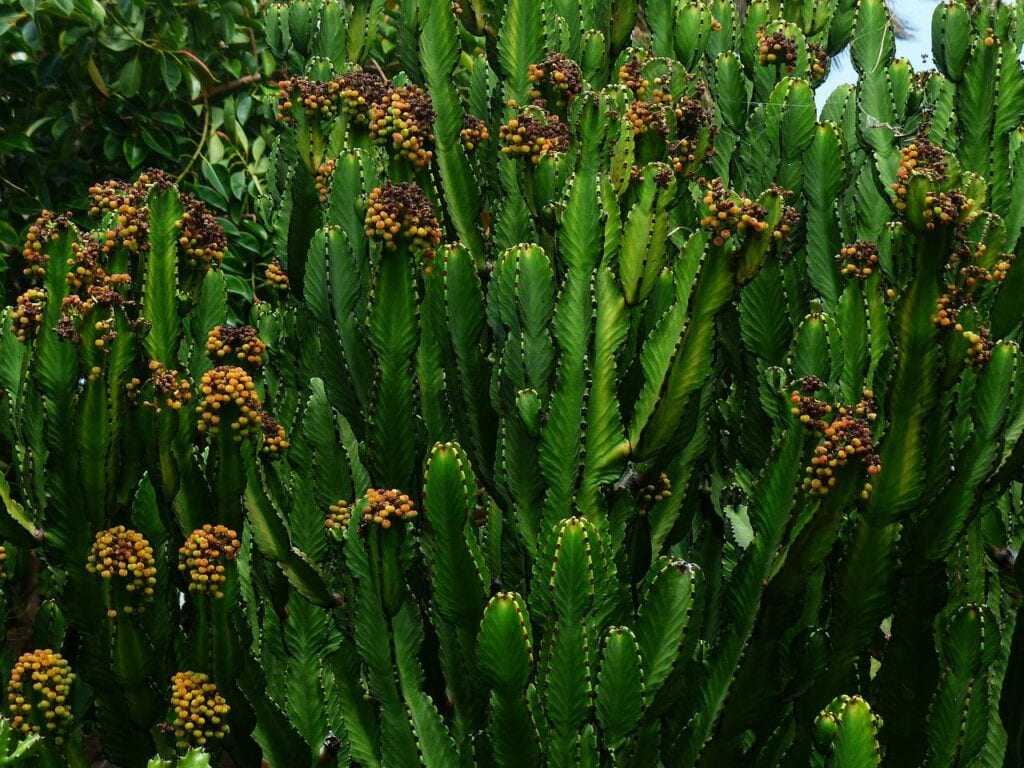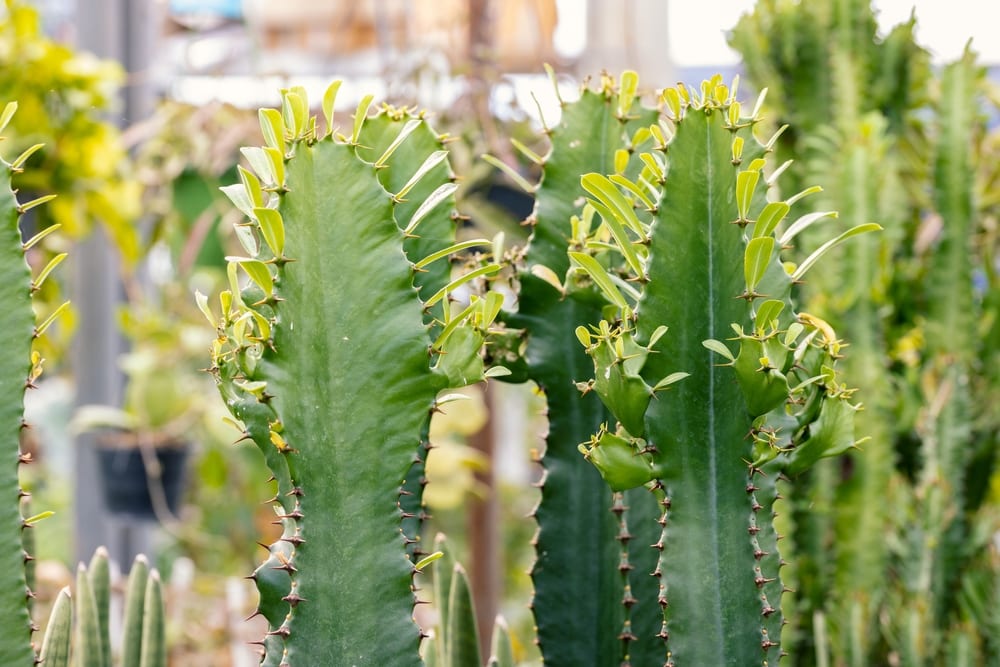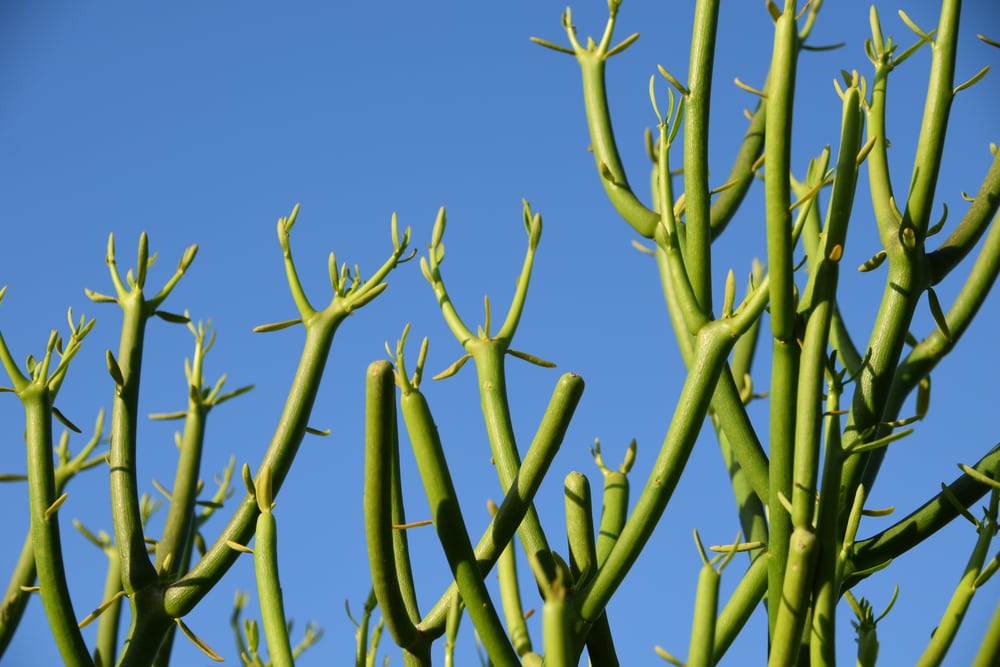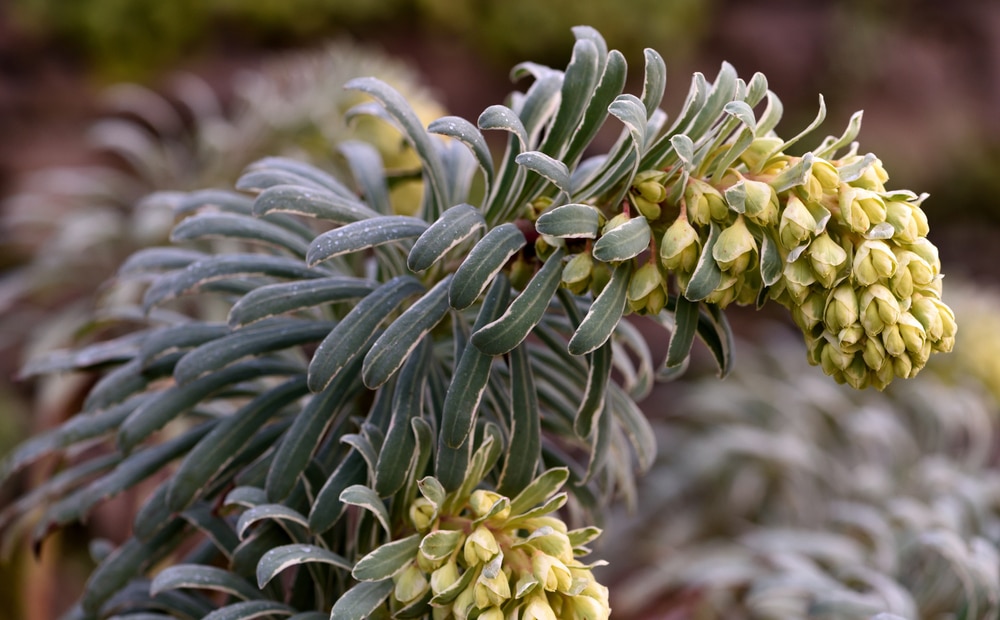30 Euphorbia Cactus Types (With Pictures)
-

- Last updated:

Euphorbia plants are an extensive genus of flowering plants belonging to the spurge family. These plants are popular in gardening, mainly as ornamental plants, because of their rich colors and unique cactus-like stems. These plants are straightforward to grow and maintain, and most stay evergreen throughout the year. Growing Euphorbias is rewarding primarily because of their drought-resistant properties and their resistance to pests, rabbits, and deer.
If you want to learn about the most common types of Euphorbias suitable for growing in your garden and that will have a stunning appearance, read the article below. We have gathered the 30 most unique and interesting Euphorbia types that are easy to grow to become a gorgeous ornamental plant.
The 30 Euphorbia Cactus Types
1. Desert Candle

| Scientific name: | Euphorbia abyssinica |
| Hardiness zone: | 9–11 |
The Euphorbia abyssinica, otherwise known as the Desert Candle, is a type of Euphorbia plant which grows in the form of a tree, with a thick central trunk and branching stems. What makes this plant distinctive are the branching stems that grow with four ribbed edges, on the end of which leaves will grow. This plant can grow up to 33 feet high if grown in well-drained soil and with plenty of natural sunlight.
2. Fireglow

| Scientific name: | Euphorbia Griffithii |
| Hardiness zone: | 4–9 |
Euphorbia Griffithii or ‘’Fireglow’’ is another fascinating variety of the Euphorbia plant. You can easily recognize this plant by its green leaves with purple stems and midribs, which are topped off by fiery red flowers. To thrive, the Firglow needs to grow in light, well-drained soil. When working with this plant, it is necessary to wear gloves, as the milky sap it produces can severely irritate your skin.
3. Shorty

| Scientific name: | Euphorbia characias subsp. wulfenii |
| Hardiness zone: | 7–10 |
The Euphorbia characias subsp. wulfenii is an attractive euphorbia plant that grows thick, yellow clumps of flowers in the early spring. This plant grows 4 to 5 feet tall on average and is a lovely addition to naturalistic, rocky gardens. It loves to sit in full sun and is drought-tolerant, so it is better to underwater it than to suffocate it with too much water. It doesn’t thrive in hot summers or humid environments, so it would be best to place it in well-drained soil.
4. Indian Spurge Tree

| Scientific name: | Euphorbia neriifolia |
| Hardiness zone: | 10–12 |
The Indian Spurge Tree is a cactus-like perennial shrub that many gardeners enjoy as an ornamental plant. This plant is drought-resistant and loves light to medium-light soil. Besides being aesthetically pleasing, the Indian Spurge Tree also has medicinal benefits.
5. Baioensis

| Scientific name: | Euphorbia baioensis |
| Hardiness zone: | 10–11 |
The Euphorbia Baioensis is a small succulent that grows in the form of a shrub with cylindrical stems. The stems can grow up to 1 foot in length, and their entire surface is covered in white spines. This species was first discovered in Kenya, on the Baio mountain, which is how this attractive-looking succulent got its name.
6. Red Monadenium

| Scientific name: | Euphorbia neorubella |
| Hardiness zone: | 10–11 |
The Red Monadenium is a Euphorbia plant that grows large and rounded green tubers with purple vertical stripes on the surface. Several smaller tubers will grow on the larger ones, and the dark green leaves will grow on the tips of the stems. While most of these plants tolerate particle shade, they mostly thrive in direct sunlight. They love well-drained soil or even poor and dry soil.
7. Debilispina
| Scientific name: | Euphorbia debilispina |
| Hardiness zone: | 10–11 |
The Euphorbia debilispina is a succulent shrub characterized by branched stems with four sides and white spines along the edges. Its unique name comes from the Latin words debilis and spina, referring to the plant’s weak and short spines. Like most other Euphorbias’, the Debilispina thrives in full sun, and it would be best to place it near a window, on a southern or southeastern side.
8. Pencil Cactus

| Scientific name: | Euphorbia tirucalli |
| Hardiness zone: | 11–12 |
The Euphorbia Tirucalli or Pencil Cactus has a unique look, with a tree-like heavy trunk, on top of which pencil-like branches will grow. The Pencil Cactus grows to 30 feet high when grown in perfect conditions. It is drought-tolerant and prefers warm, dry climates. When handling the Pencil Cactus, wear gloves because of its toxic sap.
9. Dragon Bones Tree

| Scientific name: | Euphorbia lactea |
| Hardiness zone: | 10–11 |
The Euphorbia Lactea is a cactus-like tropical shrub with several branches and smaller branches extending from the main ones. The branches aren’t bendable and have spines on their entire surface. The “Dragon Bones Tree” is toxic to humans and pets, especially the sap. During summer, it is best to water this plant once a week, although you may need to watch over it carefully to ensure you don’t overwater it. During winter, it is best not to water the plant at all—at the beginning of winter, give it one last watering.
10. Fens Ruby

| Scientific name: | Euphorbia cyparissias |
| Hardiness zone: | 4–8 |
Fens Ruby is a fast-spreading perennial that grows evergreen flowers on top of the blue-purple foliage. Even though this plant grows rapidly and aggressively, it has a short and bushy form, growing only up to 20 inches. It is straightforward to care for Fens Ruby, as it is drought-tolerant and resilient to most diseases and pests. It is perfect as a focal point for dry and sunny garden beds or borders.
11. River Euphorbia
| Scientific name: | Euphorbia triangularis |
| Hardiness zone: | 8–11 |
The River Euphorbia is a tree-shaped succulent with a few cylindrical trunks that can grow up to 60 feet tall. It consists of yellow-green branches and green flowers on the hops of branches. This plant adores the sun. Warm temperatures during summer are an ideal climate for the River Euphorbia, although low temperatures during winter may quickly kill the plant.
12. African Milk Tree

| Scientific name: | Euphorbia trigona |
| Hardiness zone: | 9–11 |
The African Milk tree is a very low-maintenance plant that grows fast when provided with all the right factors. The name Euphorbia trigona comes from the distinctive three-sided stems of this unique plant. The leaves have an adorable tear-drop shape, and if the plant is not maintained correctly, they tend to fall off quickly. These plants require a lot of natural sunlight to thrive, so if you cannot provide that, you may need a grow light.
13. Purpurea

| Scientific name: | Euphorbia amygdaloides |
| Hardiness zone: | 4–9 |
The Purpurea Euphorbia is an evergreen perennial plant that many garden lovers adore simply because of its unique dark green leaves with purple hues. This plant requires well-drained soil, although it can grow healthy in both full sun and partial shade when it comes to lighting. Water this plant only when the soil is dry to achieve the best color and results.
14. Dixter

| Scientific name: | Euphorbia griffithii |
| Hardiness zone: | 4–9 |
The Euphorbia “Dixter” is one of the most straightforward Euphorbias to grow, as it is such a low-maintenance plant. This plant is easily mistakable with the Euphorbia Griffithii ”Fireglow” because of the fiery red flowers, although Dixter has much more subtle colors and shades.
15. Wood Spurge

| Scientific name: | Euphorbia amygdaloides var. robbiae |
| Hardiness zone: | 6–9 |
The Wood Spurge is an evergreen perennial that is easily recognizable by the rosettes of deep green leaves, out of which large lime-green flowers will ascend. This plant spreads in the form of a carpet, or a low bush, on average 30 inches in width. This plant accepts full sun and partial shade and can grow healthy in both dry and moist soil.
16. Basketball Euphorbia

| Scientific name: | Euphorbia obesa |
| Hardiness zone: | 10–11 |
The Basketball Euphorbia is another fascinating Euphorbia that grows in a ball-like shape, making it an excellent, low-maintenance houseplant. This plant is easily adaptable to hot environments and requires minimal watering, making it a perfect addition to those garden lovers that can’t devote too much time to regular maintenance.
17. String of Stars

| Scientific name: | Euphorbia guiengola |
| Hardiness zone: | 10–11 |
The String of Starts is a sprawling succulent with branch-like stems. It has bright green leaves and blooms lovely white flowers. This plant is recognizable especially during winter, when all the leaves fall off but the flowers bloom, resembling little stars.
18. Vulcanorum
| Scientific name: | Euphorbia vulcanorum |
| Hardiness zone: | 10–11 |
The Vulcanorum plant got its name by the fiery appearance the flowers give out after blooming. It is a dense succulent shrub with branch-like stems. The green, and lovely branches, have attractive spines along the entire surface, with usually four angles that grow spikes on their margins. Flowers make this plant stand among the others—they are small but fiery red to orange and appear during spring and fall.
19. Cliff Spurge
| Scientific name: | Euphorbia misera |
| Hardiness zone: | 10–11 |
The Cliff Spurge is a spurge family member with soft stems and thin sprawling branches. During spring, the oval leaves will begin to appear. They are folded in the middle, and their entire surface is covered with tiny soft hairs. Cliff Spurge is a unique plant, primarily because of the milky sap the branches and leaves produce when cut or injured.
20. Nothowlee

| Scientific name: | Euphorbia Blackbird |
| Hardiness zone: | 6–9 |
The Euphorbia Blackbird ”Nothowlee” is a bushy, evergreen shrub with distinctive dark foliage. The dark greenish-purple foliage creates a stunning contrast with the bright green flowers that grow on the top and bloom in the late spring. This plant remains evergreen and attractive through the growing season and is resilient to most pests and diseases.
21. Martin’s Spurge

| Scientific name: | Euphorbia x martinii |
| Hardiness zone: | 5–9 |
The Martin’s Spurge is a bushy evergreen shrub with unique ornamental features. The green leaves grow in the form of rosettes, with stunning golden stripes on the margins. At the end of spring, the plant will bloom with creamy lime-green flowers that will receive a pink hue by the end of the season, making this plant stand out in the garden.
22. Redwing

| Scientific name: | Euphorbia x martinii |
| Hardiness zone: | 6–11 |
Red floral buds and reddish-purple stems characterize the Redwing Euphorbia. All the red shades on the flowers and stems look impressive compared to the deep green foliage. This plant can thrive in almost any type of soil, although it does require full sun to grow to its full glory.
23. Crown of Thorns

| Scientific name: | Euphorbia geroldii |
| Hardiness zone: | 10–11 |
This gorgeous-looking succulent shrub has glossy green leaves and coral red flowers. The Crown of Thorns can grow 2 feet tall and is very easy to take care of. They need very little maintenance to thrive. They will usually be healthier from neglect than overwatering, like other succulents.
24. Devil’s Backbone

| Scientific name: | Euphorbia tithymaloides |
| Hardiness zone: | 9–11 |
The Devil’s Backbone is a perennial succulent shrub with erect stems and uniquely arranged leaves that alternate opposite sides. The leaves are glossy green, with wavy margins. This plant has medicinal purposes, as you can use its entire surface for treating fractures and injuries.
25. Snowbush

| Scientific name: | Euphorbia leucocephala |
| Hardiness zone: | 10–11 |
The Snowbush is an excellent Euphorbia plant that grows creamy white bracts during summer and winter. It thrives in well-drained soil and full sun or partial shade. This plant is suitable for almost any garden because of its low requirements.
26. Bonfire

| Scientific name: | Euphorbia polychroma |
| Hardiness zone: | 5–9 |
The Bonfire Euphorbia is one of the best plants to add to your landscape since it is durable throughout all seasons. The flowers on this Euphorbia combine deep purple, red, and orange, while the underside is usually green. During summer, the foliage tends to deepen to burgundy red.
27. African Candelabra

| Scientific name: | Euphorbia ammak |
| Hardiness zone: | 9–11 |
The African Candelabra Euphorbia is a striking perennial succulent with upright branches that grow in the shape of a candelabra. The branches are thick, with wavy ribs and dark-brown spines. The entire surface of this stunning plant is colored in creamy-yellow and pale-blue shades. This plant is resilient to most pests and diseases and resistant to rabbits and deer.
28. Glacier Blue

| Scientific name: | Euphorbia ‘Glacier Blue’ |
| Hardiness zone: | 7–10 |
The Euphorbia ‘’Glacier Blue’’ is an evergreen perennial shrub with stunning foliage and long-lasting flowers. It has erect stems that grow gray-blue leaves, spirally arranged with white stripes. This plant enjoys a lot of sun exposure and dry, well-drained soil. If Glacier Blue spends too much time in shaded areas, it tends to flop and fall over.
29. Decaryi

| Scientific name: | Euphorbia decaryi |
| Hardiness zone: | 10–11 |
The Euphorbia Decaryi is a unique, lovely-looking succulent shrub that grows only up to 6 inches. It grows stunning, with wavy leaves and yellow, green, or red flowers. These plants are straightforward to grow—they require minimum effort to cultivate, and once they are established, they become self-sufficient.
30. Caribbean Copper Plant

| Scientific name: | Euphorbia cotinifolia |
| Hardiness zone: | 9–11 |
The Euphorbia cotinifolia is distinctive by its colorful leaves; even though this plant is evergreen, the leaves tend to fall off if the temperatures drop below 35°F. The height of the plant can vary from a shrub to a smaller tree, 30 feet tall. The sap from the Caribbean Copper Plant is toxic, so wear skin and eye protection when working with this plant.
Final Thoughts
The Euphorbia plant has many advantages and benefits when grown in the garden. These plants are straightforward to maintain and make your garden look stunning and quirky. Once you learn how to properly care for these low-maintenance plants, they will become self-sufficient, leaving you with a beautiful landscape requiring minimal gardening.
Featured Image Credit: Hans, Pixabay
Contents

